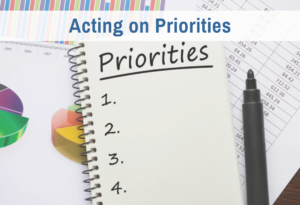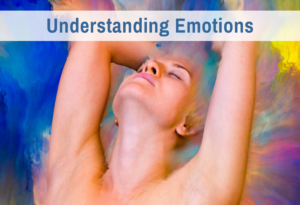In a previous article, I explained that your motivation to act results from the interaction between your present awareness and your value hierarchy. A value hierarchy is a psychological structure consisting of all of your values, interrelated with one another. Some of the connections are strong, some are weak. Some are direct, some are indirect.
VIewing motivation as the result of this interaction helps explain why you can or can’t trigger motivation to do what you think you should do.
Sometimes you can trigger motivation to follow through on a “to do” by directing your attention appropriately. If you orient toward values, or recall the reasons you should act, or recall the wider context in some other way, you trigger an impulse to “just do it.” This “works” when the relevant values are strong and directly tied to the action. In these cases, a small shift of attention activates a strong desire to act.
This is not always the case. Sometimes that small shift of attention triggers self-recriminations (“I shouldn’t be delaying”) or doubts (“I can’t do this!”). In these cases, the strong connections tie to threats instead of values. The value connections are weak.
If you want to manage your motivation, you need to understand how values are formed, strengthened, and become connected with one another. Hint: The cause is your conscious pursuit of values. And you need to know what warps and weakens the connections between values. Hint: The basic cause is passivity, but any distortions are exacerbated by inappropriately focusing on threats instead of values.
When you understand how your past actions created your value hierarchy, you gain power over your motivation. You open up action possibilities in the present. And you learn how you can reorganize your value hierarchy so that in the future, you find it relatively easy to motivate action toward your important goals. In this article I will explain how values form; in a later article I will explain how you reorganize them.
How One’s First Values Form
You are not born with values per se. You are born with basic biological needs and a motivational system to spur you to meet those needs. At the beginning, this motivational system consists of the pleasure-pain mechanism and some built-in signals that indicate the current state of your mind and body with respect to biological functioning.
Specific affective signals such as hunger, fatigue, and chilliness are alerts for the need for action—to get food, rest, shelter, etc. When you meet one of your biological needs, you experience physical pleasure. You feel satiated, alert, or cozy.
Our physiological needs with their built-in affective signals are the proto-values from which we learn to value objects in the world.
Our very first values are formed by meeting these needs. Anything associated with our own action toward meeting these needs becomes tied into the motivational system.
For example, the baby is hungry; the mother holds the bottle to his mouth, triggering a sucking reflex. The baby ingests milk, which sates the hunger, causing the baby pleasure. The bottle become associated in the baby’s mind with meeting this need and experiencing this pleasure. He has a similar experience when his father holds the bottle. And when another caretaker does. At some point in the future, if the baby is hungry and he sees the bottle held by someone new, he will recognize it and desire it.
The bottle has now become a value in the psychological sense. It is desired by the baby because it has satisfied his hunger in the past. If he is hungry, getting the bottle will bring him a feeling of satisfaction even before he starts to drink. Losing the bottle will bring dissatisfaction.
These basic forms of satisfaction and dissatisfaction have names. We call them emotions. Joy is the feeling you have when you gain a value. Grief is what you feel when you lose one. Desire is what you feel when you see a value and your action can help you get it.
Through this associative mechanism, a baby’s first values form. Many concrete objects become connected with the pleasure of meeting basic physical needs, and as a result they can trigger emotions themselves. This is what it means to say they become values. The most obvious evidence that a value has formed is that you feel love just by contemplating the object, apart from any pressing need.
For example, the mother becomes associated with meeting many, many needs. Very soon, the baby loves the mother whether she’s feeding him or changing him or not. He’s glad when she is around.
Incidentally, these first, simple cases of value-formation involve two important factors that may not be obvious.
First, self-generated action is inherent in the process. The baby needs to suck to ingest the milk. In this simple case, the self-generated action is an unchosen reflex. But it is his action. For something to be programmed as a value in your mind, you need to take action to gain and keep it.
Second, values form in a structure. There is no such thing as an isolated value. One’s first values form in relation to biological needs. In the next section, we will see that later values form on the basis of existing values. All values are relational; once you form values, they necessarily exist in some structure, which is your value hierarchy.
Purposeful Action: The Engine of Value Formation
Value-formation accelerates once the baby can take purposeful action.
At a certain point, a baby can initiate action; he doesn’t just suck by reflex when the bottle touches his face. When he is hungry, he imagines his bottle. To get it, he cries to get the attention of his mother, the bringer of bottles. When she talks to him, he makes sounds back, which seems to speed up the process. When she brings the bottle near, he reaches for it. Because he lacks language, a baby’s purposeful action is limited to the perceptual level, like a dog or cat’s behavior. But it has the basic elements that exist in mature purposeful action.
Purposeful action is action in which you hold a value (i.e., your purpose) in mind as something you want to attain right now. You use this purpose to guide the actual steps you take. For example, when you go to the shoe store, you hold your destination in mind as you get in the car and start driving. At each intersection, you use your destination as a standard to decide which way to go. If you don’t keep your destination actively in mind, auto-pilot will kick in. Instead of driving straight at the intersection to go to the shoe store, you’ll make your habitual right turn for the grocery store.
Mature purposeful action transforms and accelerates the value-creation process through self-awareness of one’s own efficacy.
Efficacy is simply “the ability to produce a desired or intended result.” When you choose to initiate an action to gain a value and you succeed, you multiply your pleasure. There is a satisfaction, not just in getting the value, but in seeing that you can get values.
Think of a small boy saying, “Let me do it.” The child doesn’t just want the result; he wants to prove he can get the result through his own effort.
Efficacy is a deep rational value, but it is only grasped as such by self-awareness. Once you see the role of your own action in gaining things you want, you also see that this efficacy helps you gain any value and meet any need.
After you grasp this benefit, you start feeling emotions concerning your own efficacy.
When you succeed by your own effort and you see it, you will feel pride. Once you have enough experience to predict success, you will feel confidence. These two pleasurable emotions are the reward of your growing capacity to gain values in the world. Having efficacy makes the difference between whether you are a pawn of external forces or the master of your fate. And at some level, everyone appreciates that.
Summary: Three Ways Values Are Formed and Strengthened
This then explains how values are formed and strengthened by everyday purposeful action. You have a value you want, you hold it in mind as a purpose, you act to gain it in the here and now, and, most of the time, you achieve it. The value is formed and strengthened by three mechanisms:
a) A Value-Oriented Reason: If you choose your purpose because it is a means of achieving some valuable end, you establish the named purpose as valuable, and you reinforce the value of the longer-range end
b) Self-Generated Action: Acting to achieve the purpose reinforces its value by linking it with self-generated action
c) Observed Success: The pleasure you get from your own efficacy augments the pleasure you get from gaining the value, reinforcing it as a value
If you are reasonably productive, you constantly undertake and succeed at purposeful action. As a result, you form and strengthen values every day. You implicitly organize your values as means and ends to one another. You become a valuer in every area of life.
By the time you reach adulthood, you have formed thousands of values through your purposeful action. They are all interrelated in one way or another.
How Value Connections Become Warped or Weakened
So far, I’ve explained how values form when you successfully take purposeful action that is oriented to gaining values that support your life. But that kind of action and that result are not the only possibilities.
The obvious question is, what happens if you fail? Then you will feel frustration and/or guilt, not confidence and pride. Won’t those painful feelings undermine the value-forming process and sap your motivation? They can if you don’t handle them right. If you do nothing, you will associate these unpleasant feelings with that process, and you will develop an aversion to taking that action. You will have both desire and aversion (i.e., conflict) for the same object. This ambivalence toward your values is the source of many motivational problems.
Some failures, mistakes, and setbacks are to be expected, especially if you undertake a new, ambitious project. You need a robust method for recovering from failure and resolving such conflicts if you want to create vigorous long-term motivation.
Another possibility is that you don’t take the action. After all, it’s a choice. If you have the chance to gain a value and you don’t take it, you reduce its strength, i.e., its relative importance to other values. In practice, you are normally choosing one value over another. You decide to move to another city from the one you’re in. You decide to date one person not another. Absent other factors, when you choose one value over another, the chosen value is strengthened and the rejected value is weakened.
There are two other important cases that can’t be ignored.
First, not all purposeful action is aimed at achieving values. Sometimes action is chosen to avoid a threat, not gain a value. Such a choice organizes your motivation around avoiding threats rather than gaining values. When avoiding threats becomes your main focus, the threat takes on a larger significance in your mind and can become an object of permanent fear, analogous to a value. I call this an anti-value. Anti-values create massive conflict in significant areas of your life and can paralyze you. Ultimately, they motivate destruction, not creation.
Second, not all action is purposeful. You initiate purposeful action deliberately. It takes effort. If you don’t make the effort, you will react unthinkingly to events, without ever identifying values or holding any defined purpose in mind.
If you have set up some habits, you might go through the motions for a while. But, life-affirming habits, although they rely on automatization and take relatively little effort, still require purposeful action to maintain. The world changes around you. You need to monitor the routine and make small adjustments to ensure you stay pointed toward values.
If you don’t make an effort to keep the routine goal-directed, you will default to the easier path: the path that feels better or the path that avoids something new and scary. In other words, you will go by emotions.
At best, you will become stuck in a rut, always going in the direction you usually go. You may identify something new as a bigger value in theory, but the motivational pull of the old way will feel stronger. If you go by feelings, there will be an increasing mismatch between what you consciously believe to be your values, and what value connections are programmed in your subconscious.
The bigger problem is that threat-based emotions are more intense than value-based emotions because they are designed to alert you to emergencies. That means that over time, threat-based motivation comes to dominate your life.
Your Value Hierarchy
As an adult, you have the values you have, interrelated the way they are, with perhaps an anti-value or two. This is your value hierarchy. It is the causal result of all of your past choices and actions.
If you generally have the motivation you need to pursue your goals, your value-hierarchy is well organized for you. When you find that you’re not instantly motivated to do what you should do, you can trigger motivation to follow through by directing your attention toward values, as I mentioned in the opening.
Moreover, if you are systematically value-oriented, you will keep your value-hierarchy organized. You will choose every action on the basis of gaining a value and process every failure in a value-oriented way. These are the methods I teach in my programs.
These same methods will gradually organize your value-hierarchy over time.
If you are in a hurry — if you want to reorganize your value hierarchy to eliminate conflict and achieve your goals faster — you can speed up the process if you are strategic. In the next article, I’ll talk about how you do that without inadvertantly sabotaging yourself with threat-based motivation.
Hint: Why are you in such a hurry? If your hurry is motivated by avoiding something awful, you will need to re-orient toward values at the root.
Ultimately, you can organize your value-hierarchy around any value-creation vision you have for your life. That is what the value system is designed for. And when you use it as designed, it is grand.








This is beautifully concrete, explicit, useful and motivational. Thanks again
Thank you, Dwight!